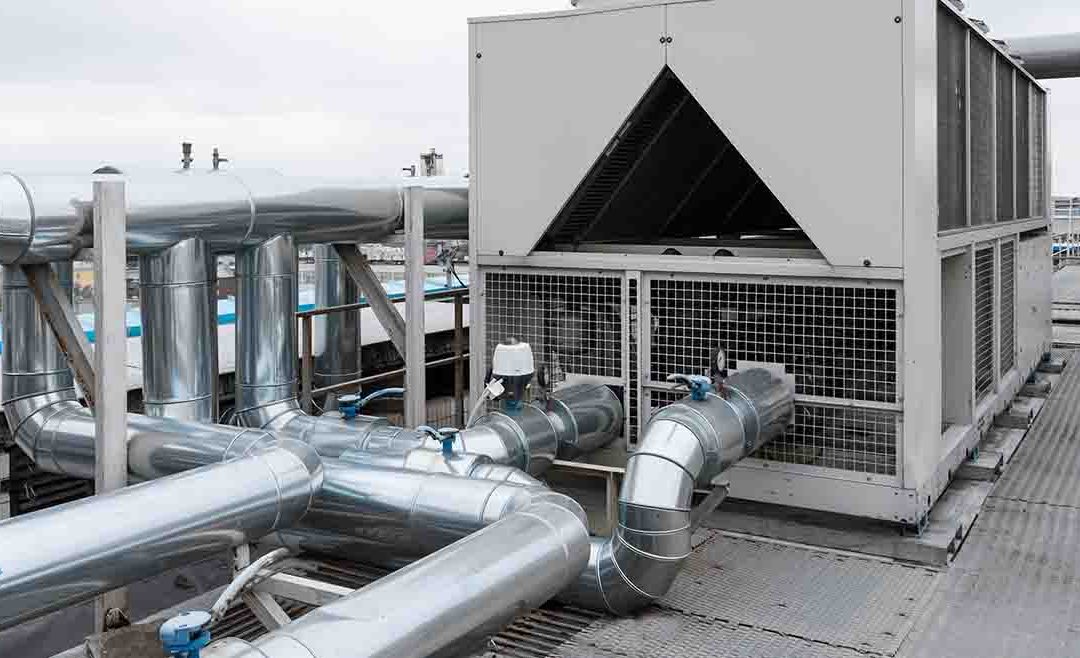Load Calculation and Sizing:
Determining the system’s cooling load requirements precisely is one of the core components of chiller design. This involves assessing elements including the area that needs to be cooled, the size of the equipment that produces heat, the number of occupants, and the conditions in the surrounding area. An undersized chiller may find it difficult to meet cooling demands, which could result in inefficient operation and possible system breakdowns. An oversized chiller would result in needless energy use and greater running expenses. To properly size the chiller and maximize its performance, a thorough load estimate must be performed.
Refrigerant Selection:
The design of a chiller is greatly influenced by the refrigerant selection, which affects system performance and environmental sustainability. Refrigerant selection with low global warming potential (GWP) and ozone depletion potential (ODP) is becoming more and more important as rules aimed at decreasing greenhouse gas emissions become more stringent. In addition, factors like cost-effectiveness, safety, and energy efficiency need to be taken into consideration. There is a growing trend in the industry toward the use of natural refrigerants like carbon dioxide and ammonia, or hydrofluorocarbons (HFCs) with reduced greenhouse gas footprints. To guarantee regulatory compliance and reduce the environmental impact of chiller operation, a thorough assessment of possible alternatives is necessary.
Efficiency and Energy Conservation:
Since efficiency has a direct impact on operating expenses and environmental sustainability, it is an essential component of chiller design. High energy efficiency ratios (EER) and coefficient of performance (COP) chiller designs can drastically lower energy usage and operating costs during the system’s lifetime. To improve chiller efficiency, a variety of design elements and technologies can be used, including compressors, variable-speed motors, and sophisticated control algorithms. Further enhancing overall energy conservation can be achieved by appropriate system integration, which includes the best possible piping architecture, insulation, and control systems. Stakeholders can minimize their carbon impact and save a significant amount of money by designing chillers with efficiency as their priority.
Considerations for Reliability and Maintenance:
In the design of chillers, reliability is crucial, particularly in critical applications where downtime can result in serious disruptions and monetary losses. Reliable chiller functioning requires the integration of robust components, redundant systems, and proactive maintenance procedures. Aspects like spare part availability, simplicity of maintenance, and equipment accessibility are to be considered in the design stage as well. Predictive maintenance methods, including condition monitoring and remote diagnostics, can also be used to find possible problems before they become expensive breakdowns, improving system uptime and reliability.
Environmental & Regulatory Compliance:
To reduce the environmental impact of cooling systems, chiller design must be in line with sustainability programs and environmental regulations. Adherence to international norms and local laws governing the use of refrigerants, energy conservation, and emissions is essential. A dedication to environmental responsibility can also be shown by obtaining green building certifications like LEED (Leadership in Energy and Environmental Design), which can also increase the marketability of buildings with sustainable cooling systems. Stakeholders can support international efforts to reduce climate change and advance sustainable development by giving regulatory and environmental compliance top priority when designing chillers.
Integration with Building Management Systems (BMS):
To enable centralized control, surveillance, and optimization of HVAC operations, chillers are frequently integrated with BMSs. Real-time monitoring of chiller performance, remote diagnostics, and automated modifications based on occupancy schedules, weather, and energy consumption is made possible by seamless connectivity with BMS platforms. BMS-integrated chillers may minimize energy consumption, proactively find opportunities for efficiency gains, and dynamically adjust to changing load requirements by utilizing advanced data analytics and machine learning algorithms.
Control of Noise and Vibration:
The environment, employee efficiency, and occupant comfort can all be negatively impacted by the noise and vibration that chillers produce. These worries can be reduced by designing chillers with noise and vibration control features like vibration isolation mounts, sound-insulated enclosures, and variable speed compressor technology. Furthermore, to reduce the amount of noise that is transmitted to nearby spaces, chillers should be placed strategically, and acoustic design principles should be taken into account during installation. Stakeholders can comply with neighborhood noise regulations and regulatory standards while creating a comfortable indoor atmosphere by giving priority to noise and vibration reduction in the design of chillers.
Future-Proofing and Flexibility:
Chillers must be designed with inherent flexibility and scalability to allow for future upgrades and alterations, considering the rapid pace at which technology is developing and the constantly changing regulatory requirements in the HVAC sector. Future expansion or integration of additional features, including heat recovery systems, renewable energy sources, or sophisticated control strategies, can be made easier by choosing flexible components, adopting standard layouts, and planning for the simplicity of retrofitting. By designing chiller systems with the future in mind, stakeholders may adjust to shifting consumer needs, legal requirements, and technical advancements, maintaining their long-term relevance and competitiveness in the market.
Water Quality and Treatment:
In systems that use evaporative cooling towers or water-cooled condensers, the quality of the water has a significant impact on the lifespan and functionality of chillers. The efficiency and dependability of chillers can be impacted by variables like hardness, pH levels, dissolved solids, and microbiological pollutants. Preventing scale formation, corrosion, and biological contamination in the chiller system requires the implementation of appropriate water treatment techniques, which include filtration, chemical treatment, and routine maintenance. By adhering to industry best practices for water treatment and conducting routine monitoring of water quality indicators, operational risks can be reduced and chiller service lifespan can be increased.


